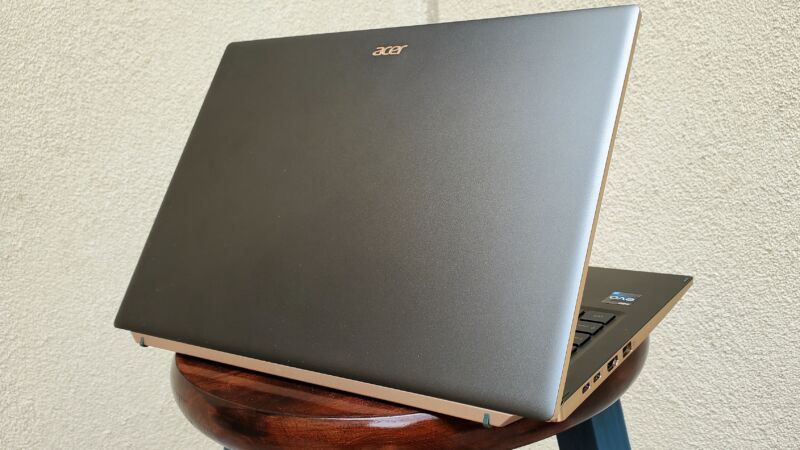
| Specs at a glance: Acer Swift 5 (SF514-56T-797T) | |||
|---|---|---|---|
| Screen | 14-inch 2560×1600 60 Hz IPS touchscreen | ||
| OS | Windows 11 Home | ||
| CPU | Intel Core i7-1260P | ||
| RAM | 16GB LPDDR5 | ||
| Storage | 1 TB PCIe 4.0 SSD | ||
| GPU | Intel Iris Xe (integrated) | ||
| Networking | Wi-Fi 6E, Bluetooth 5.2 | ||
| Ports | 2x USB-C (Thunderbolt 4), 2x USB-A (3.2 Gen 1), 1x HDMI 2.1, 1x 3.5 mm jack | ||
| Size | 12.22 x 8.4 x 0.59 inches (310.5 x 213.3 x 14.95 mm) |
||
| Weight | 2.65 lbs (1.2 kg) | ||
| Battery | 56 Whr | ||
| Warranty | 1 year | ||
| Price (MSRP) | $1,500 | ||
The Acer Swift 5 ($1,500 MSRP) may not be your dream ultralight laptop, but it's not a bad one. You won't squeeze the most performance out of the Swift, and its touchpad still bothers me after weeks of use. But with perks like a good port selection and a strong keyboard, the laptop is worth a look if you want to save some money. Even though there are some compromises, it's a decent option with a lower price tag than similarly specced alternatives.
Table of Contents
Colorful design
The Swift 5 is priced lower than other ultralights with 12th Gen CPUs, a fact that is apparent when you hold it. According to Acer, the chassis is made from 6053 aluminum alloy with a 75 HV hardness and anodization to fight degradation (its gold accents are double-anodized). But instead of a luxurious metallic-like finish, like Lenovo's Yoga 9i carries, it looks and feels like lightweight plastic that can still fall victim to scratches.
Subtle texturing helps the design, though, and prevents the laptop from feeling too slippery during use. The keyboard showed subtle flex when I typed aggressively, and that flexing became more apparent when I pressed down on the keyboard.
Despite those shortcomings, the Swift 5 doesn't look bad. It comes in a forest green with gold accents (Acer told me that there may be a blue option eventually). The green finish showed a subtly sparkly finish, and the deep coloring and brushed finish of the gold sides looked particularly attractive. If you're sick of gray, silver, and black laptops, the Swift 5 provides a refreshing look.
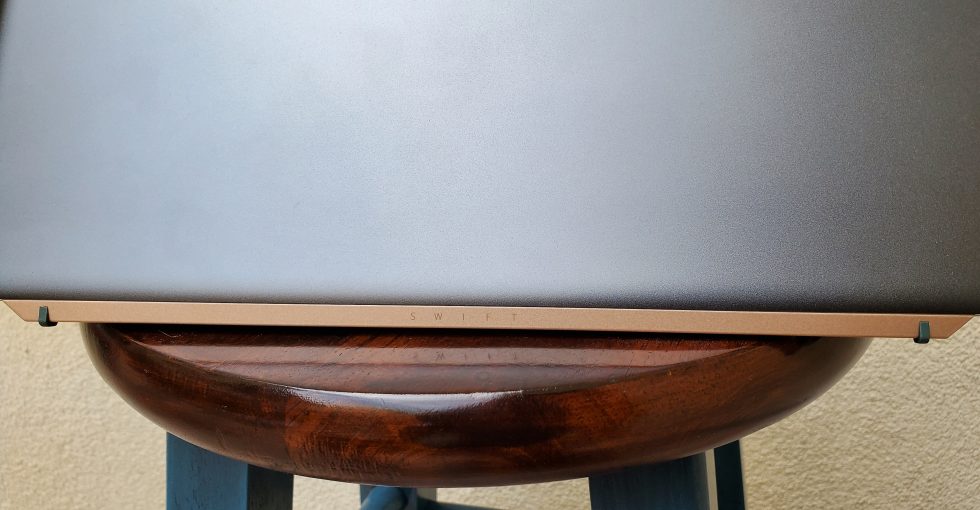
The Swift's decorative spine is more about form than function, though. I would prefer to be able to push the laptop's screen back far enough to make it level with the keyboard, but that's not possible. This may not be an issue for some buyers, but it prevented me from using the laptop on the couch or on my lap at max comfort. Since it's an ultralight laptop weighing just 2.65 lbs, more flexibility would make sense.
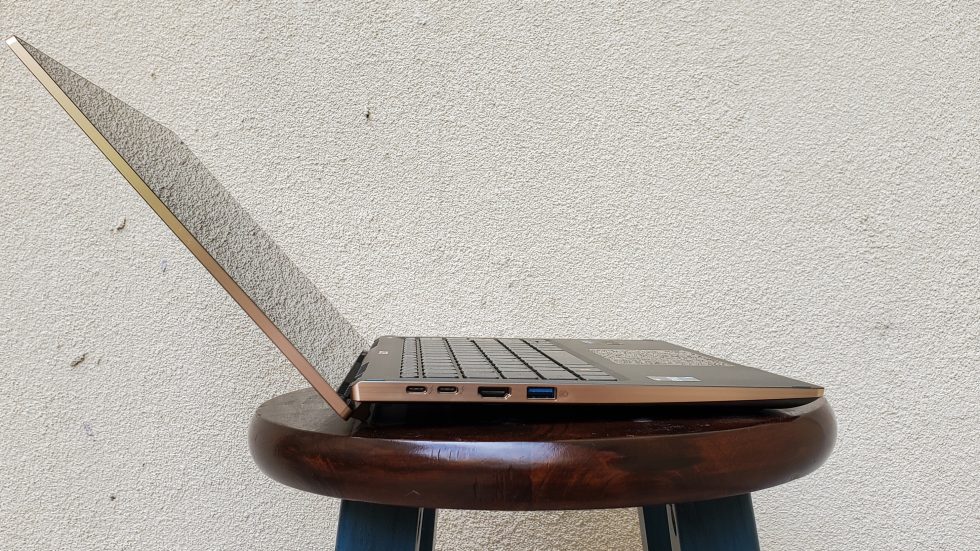
One place Acer didn't skimp is port selection, especially when you compare the Swift 5 to the many laptops skipping anything but USB-C these days. The Swift 5 has two Thunderbolt 4 ports on the left side, including one for charging, plus an HDMI 2.1 port and USB-A on the left. The right side has another USB-A port, a headphone jack, and a Kensington lock.
 Left side.Scharon Harding
Left side.Scharon Harding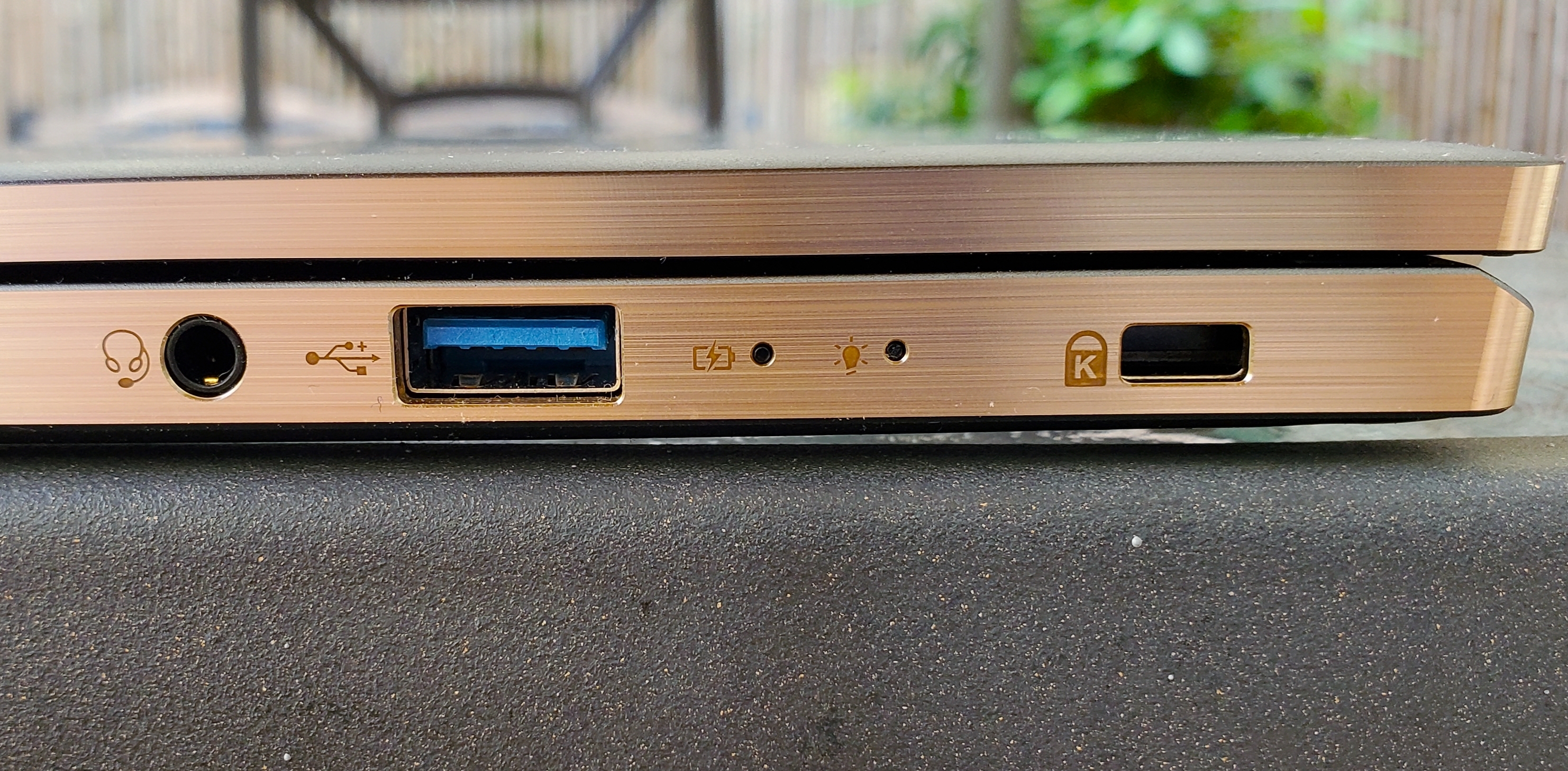 Right side.Scharon Harding
Right side.Scharon Harding
A small note: There are two lights on the side of the laptop representing battery and power. I found their colored lights (one of which is always on) mildly distracting in dark rooms or when using the laptop plugged into my TV for entertainment.
Wobbly touchpad
When I first used the Swift 5's touchpad, which Acer says is made of plastic waste, I thought I had received a faulty review unit. When pressing the touchpad, it would move down within its border before it would even click. However, Acer told me that this is by design. The wobbly touchpad made for clunky clicks—and sometimes, unwanted wobbliness during navigation. It also made the laptop feel cheaper than it should.
The touchpad is nice and smooth, though. Running a finger across it feels like gliding atop glass or the touchpad of some of the most popular thin-and-light laptops, such as the Dell XPS series.
Satisfactory keyboard
The Swift 5's keyboard is a highlight, and not just because of its sharp, gold font.
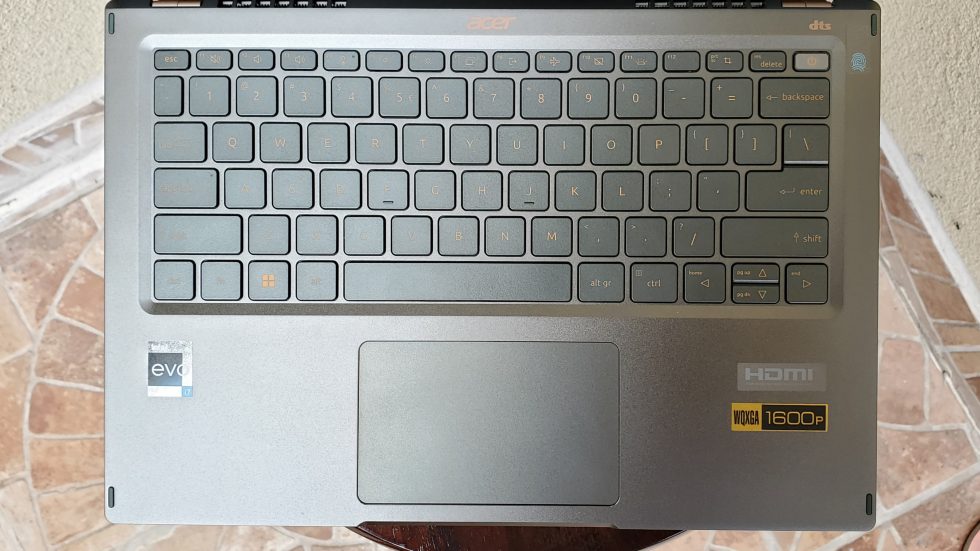
The keys have 1.3 mm of travel, and they're snappy and responsive. Most keys go down quickly and reset with a gentle plastic thud; larger ones come with a subtle rattle.
There are also useful tools in the function row, including a mic toggle, volume control, Snipping Tool, and a "log out" key. The power button, meanwhile, doubles as a fingerprint reader. There are no media control keys.
Acer also cleaned up the keyboard from last year, reducing the arrow section to four keys instead of six (including Page Up and Down keys) and eliminating the secondary numpad in the alpha rows.
F11 is preset to toggle through the keyboard backlight's three brightness settings, including "off." I'd prefer no backlight at all, though, because the lighting is uneven and unhelpful. With the backlight brightness maxed out, only the bottom perimeter of the function row is sufficiently lit. Some of the alpha keys, mostly on the left side, have scant lighting. The backlight does nothing to make the keys or their legends easier to see.
Performance
The Swift 5 I reviewed (model SF514-56T-797T) is the only 2022 configuration available, at least for now. Acer told me additional options are possible for the fall/holiday season.
The PC runs on an Intel Core i7-1260P, which hails from the P-series Intel introduced with its 12th Gen mobile CPUs. The P-series is similar to the H-series but is expected to run at max speeds for a shorter amount of time. The i7-1260P has four performance cores (2.1–4.7 GHz), four efficient cores (1.5–3.4 GHz), 16 threads, and 18 MB of cache.
The laptop has three performance modes: silent, normal, and performance. I often forgot they existed, though, because the only way to toggle through them is by pressing Fn and F, which you wouldn't know by looking at the keyboard. Performance mode provides up to 28 W to the CPU (up from the 2021 Swift 5's 19 W).
Additionally, the Swift 5 has a 1TB NVMe PCIe 4.0 SSD and one stick of 16GB of LPDDR5 RAM. Acer doesn't specify the speed, but my stick was running at 4,800 MHz.
For comparison, I've brought in a few other Intel Evo ultralight laptops, including some 2-in-1s:
| Model | CPU | Graphics | RAM | SSD | Other | Price (as of press time) |
|---|---|---|---|---|---|---|
| Acer Swift 5 | i7-1260P | Intel Iris Xe | 16GB LPDDR5-4800 | 1TB | 2560 x 1600 IPS touchscreen | $1,550 |
| Lenovo Yoga 9i | i7-1260P | Intel Iris Xe | 16GB LPDDR5-5200 | 512GB | 2800×1800 90 Hz OLED touchscreen | $1,730 (MSRP) |
| Lenovo ThinkPad X1 Extreme Gen 4 | i7-11800H | Nvidia GeForce RTX 3070, Intel UHD | 16GB DDR4-3200 | 512GB | 3840 x 2400 IPS touchscreen | $2,327.40 |
| MSI Summit E13 Flip Evo (2021) | i7-1185G7 | Intel Iris Xe | 32GB LPDDR4X-4267 | 1TB | N/A | $1,700 |
Benchmarks
Note that we recorded the ThinkPad's numbers with the laptop in its "balanced performance" mode rather than its "high performance" mode to help with heat management. The Swift 5 was in performance mode.
The Swift 5 and Lenovo Yoga 9i have the same processor, but because it has different design and faster RAM, the Lenovo bested the Acer in single-core and multi-core performance. Acer's machine outperformed the comparison machines using last-gen i7 CPUs.
Acer's performance mode seemingly favored single- over multi-core performance. With the mode off, the Swift 5 averaged better in Geekbench 5's multi-core testing (9,887 average overall versus 9,193).
Based on numbers scored in the CPDT benchmark, one of the Swift 5's standout performance attributes is storage speed. The laptop recorded sequential read and write speeds of 3.85 and 1.84 GBps, respectively, and respective random read and write speeds of 78.78 and 153.18 MBps.
We've started using this benchmark more recently, so we don't have results for all the comparison machines, but the pricier Yoga 9i we tested had a slightly slower SSD with respective sequential read and write speeds of 3.81 and 1.55 GBps and random read and write speeds of 51.58 and 78.43 MBps.
Graphics performance
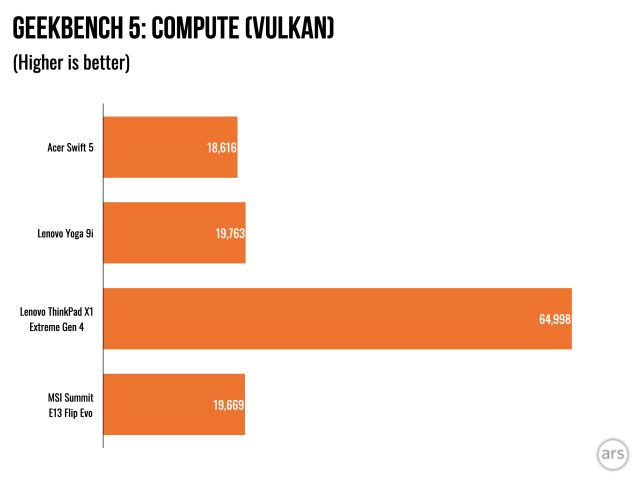
The i7-1260P in the Swift 5 and Yoga 9i uses integrated Iris Xe graphics at a faster max frequency (1.4 GHz, 96 execution units) than the MSI E13 Flip Evo's last-gen CPU (1.35 GHz, 96 EUs). The Yoga 9i's number in the chart above depicts that, but the Swift 5 doesn't appear to make the most of its processor's graphical potential.
I also ran the 3DMark Wild Life Extreme benchmark on the Swift 5. It scored 3,922 compared to the Yoga 9's 4,144.
Cooling
The Swift 5's high-contact areas warmed up quickly during use. It took just a few minutes of moderate use for the keyboard to feel noticeably hotter. It took longer (at least 30 minutes) for the backside and area north of the keyboard to be too hot to touch comfortably. And while the keyboard did get warm at these times, its keys didn't get too hot for typing.
The laptop has two fans with 59 blades each, delivering a total fan volume of 27,500 mm³, according to Acer. A stereo ring with an inclined plane tops the fans to bring in more air. There's also a wider air vent than the one in the 2021 Acer Swift 5.
All this supposedly makes the laptop performance up to 47 percent better than the preceding Swift 5, Acer says, and provides a 10 percent improvement in airflow.
The laptop also has a pair of D6 copper heat pipes, and its keyboard uses an air inlet design that pushes out 8–10 percent more heat than a regular laptop keyboard, according to Acer.
Battery life
Acer says the Swift 5's battery lasts for up to 9.5 hours on the MobileMark 2018 benchmark and up to 14 hours during web browsing or video playback with the screen set to 50 percent brightness.
For comparison, the Yoga 9i we tested had a power-hungry OLED screen to deal with, resulting in a battery life of 10.5 hours on Mobile Mark 2018 and 14 hours with 1080p video playback, each with the screen set to 150 nits. The estimates drop to 13 and 23 hours, respectively, for non-OLED configurations.
Meanwhile, the ThinkPad X1 Extreme lasted for 8:23 on the PCMark Modern Office test when we set the screen to 200 nits and used the laptop's middle-grade balanced mode. Finally, the MSI 2-in-1 claims up to 20 hours of battery life while using its power-saving mode.
According to Acer, you can get up to 4.5 hours of battery from 30 minutes of charging with the Swift 5's 65 W USB-C adapter.
Display
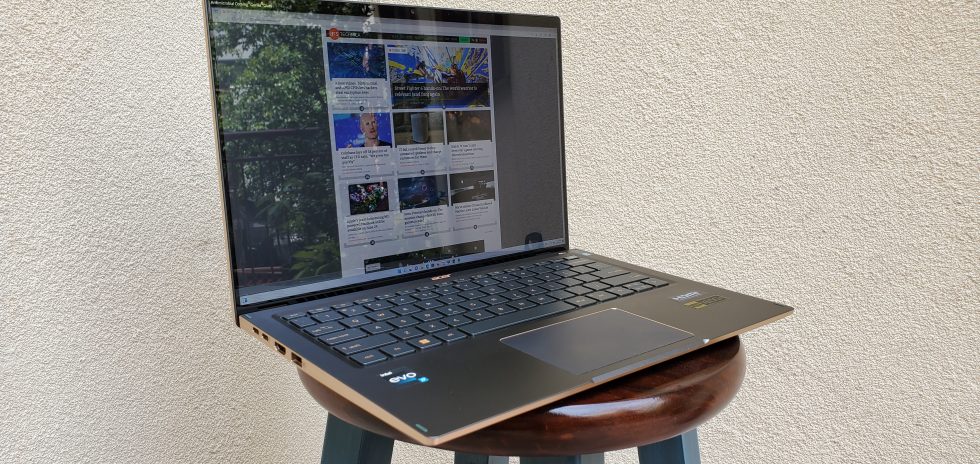
Acer upped the resolution and height of the Swift 5's screen compared to the 2021 Acer Swift to help it better compete with laptops in its price range. The 14-inch glossy IPS LED touchscreen is now 16:10 and 2560 x 1600 (versus 16:9 and 1920 x 1080 last year).
The taller aspect ratio fits a trend dominating laptop releases this year. Interestingly, this is a true 16:10 screen, making it slightly taller than the Yoga 9i's display, which is closer to 16:10.5. Notably, Lenovo offers the Yoga 9i with an IPS OLED, 90 Hz display, compared to the Swift 5's 60 Hz.
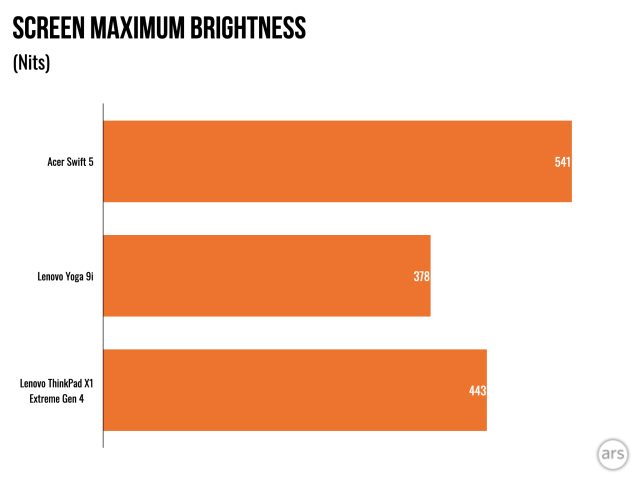
My review unit's screen averaged 540.6 nits, which made it bright enough to use outside, even on a sunny summer day. There were decently strong reflections, but I was still able to see my work. Those reflections were a nuisance when watching movies, though, especially considering the thicker black bars on 16:9 films. Colors appeared on-point but not exceptionally vivid or saturated. I recorded 83.1 percent DCI-P3 coverage on the display, and Acer claims a contrast ratio of 1,200:1.
The Yoga 9i's OLED screen tested notably dimmer but is also more colorful. We recorded a max brightness of 378 nits on the machine and 123.2 percent DCI-P3 combined with theoretically infinite contrast.
Meanwhile, the ThinkPad showed similar color coverage (81.5 percent P3) to the Swift 5 and was slightly dimmer (443 nits) with slightly higher contrast (1,391:1) during testing, while the MSI claims 500 nits, 100 percent P3 coverage, and 1,000:1 contrast.
Like with the prior Swift 5 and other Acer laptops, the screen here uses Corning Gorilla Glass, which is supposed to make it tougher and scratch-resistant. The display is also antimicrobial. Acer claims the screen fights bacteria by incorporating an agent made with silver ions, which years of research suggest can fight bacteria by absorbing enough biomolecules, like DNA and enzymes, to stop bacteria from functioning. It's nice to have on a touchscreen.
Audio and webcam
The Swift 5 has a pair of front-facing stereo speakers under the left and right bottom corners of the deck, and they should be more bass-heavy than the speakers on the 2021 Swift 5. Occasionally, audio sounded muffled, and I sometimes wished for a little more volume. But in a quiet environment, the speakers sounded decently full for laptop speakers.
The laptop comes with DTS Audio, and although the software's preset profiles didn't prove useful, some of the options, like treble enhance, vocal boost, bass boost, and the graphics EQ can help improve default audio a bit.
Upgraded webcam
Acer upgraded last year's 720p webcam to 1080p. The company says the camera uses temporal noise reduction to boost image quality when the camera is used in low lighting.
I found the webcam's color to be quite vivid, even in low lighting conditions, though it occasionally made my skin tone look a little blown out. The image was pretty sharp and color-accurate for a laptop shooter.
To accompany web calls and other verbal communication, the laptop has two 33 mm far-field microphones on either side of the webcam; Acer says they use AI-based noise reduction and adaptive beam forming.
You can probably do better
Acer's Swift 5 is a few hundred dollars cheaper than rival ultralight laptops featuring current or last-gen Intel CPUs and/or less storage. But if you're willing to pay extra, you can do better. Design shortcomings, like a wobbly touchpad and plastic-like chassis, make the laptop feel noticeably cheaper than some alternatives, such as the shiny Lenovo Yoga 9i 2-in-1.
The Swift 5 stands out with a pleasing color scheme and comfortable keyboard. Plus, it doesn't skimp on ports, and the display is comparable to competitors. But if you prioritize performance, it may be worth it to spend a little more on another laptop. It's all about what type of compromises you're willing to make.
The good
- A bit cheaper than similarly specced ultralights
- Solid port selection
- Good keyboard travel
- Webcam looks sharp and colorful, even in darker rooms
The bad
- You can get better performance from other laptops with the same CPU
- Can't lay flat
- Keyboard backlight is laughable
The ugly
- Clunky, wobbly touchpad
Ars Technica may earn compensation for sales from links on this post through affiliate programs.
https://ift.tt/ay7cv3S
Technology
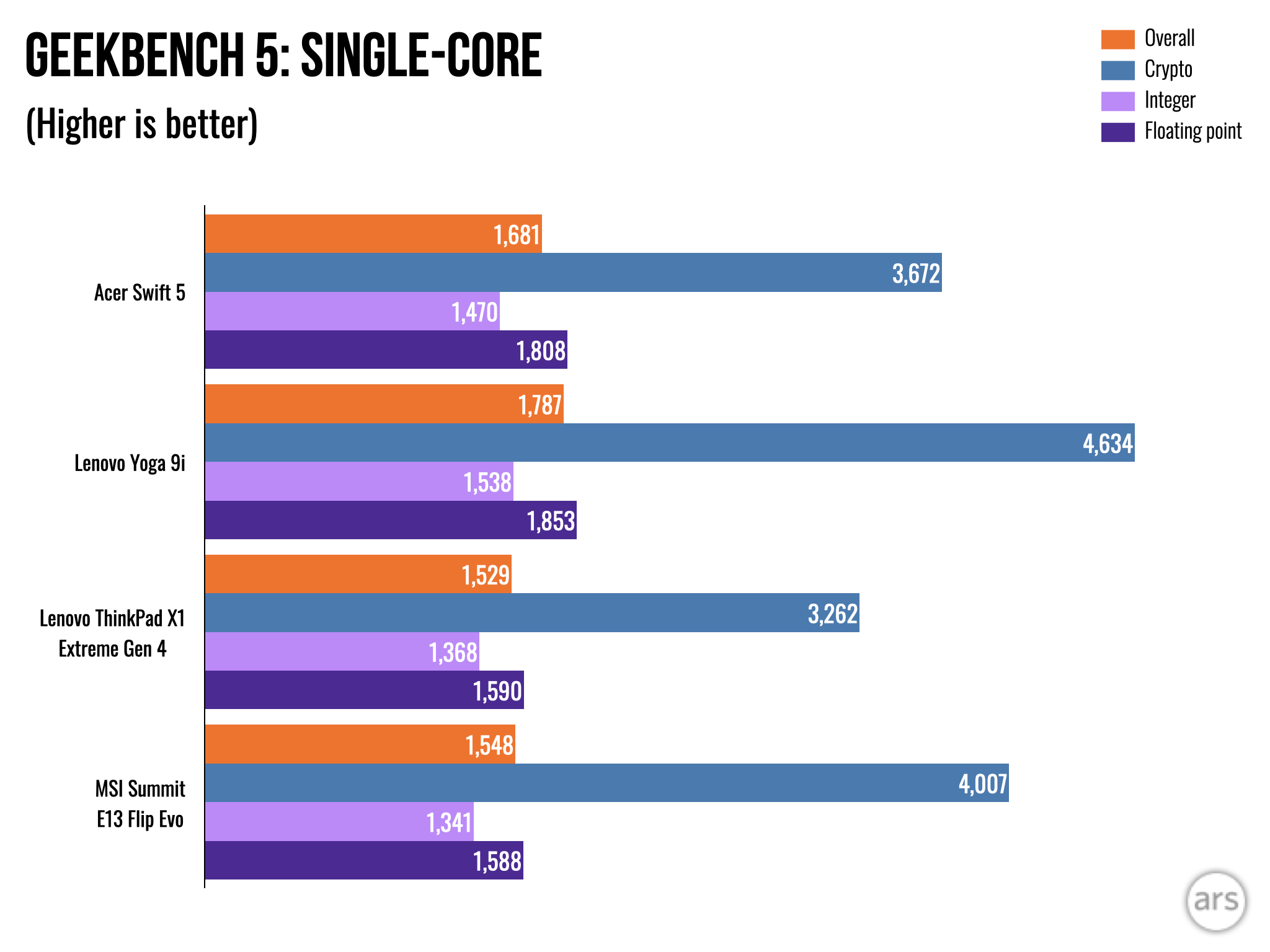
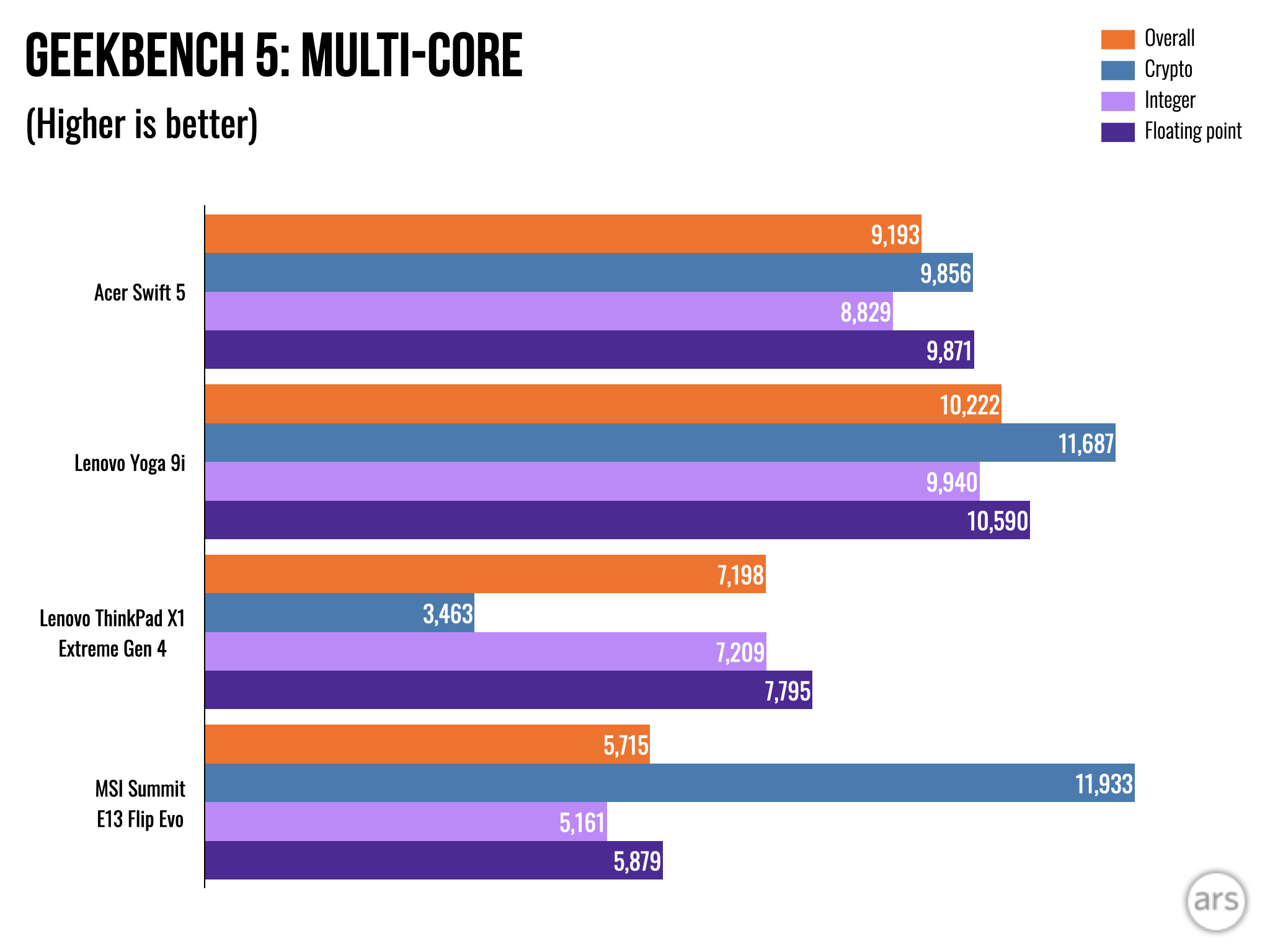

No comments:
Post a Comment